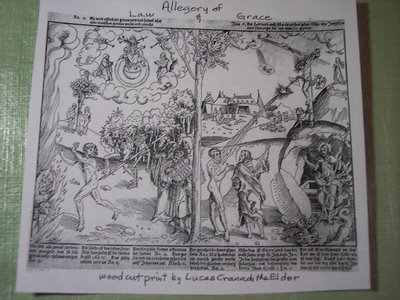Amazing Grace Pt. 2
 This is the masterpiece woodcut I was referring to in "Amazing Grace Pt. 1". It is called, "Allegory of Law and Grace by Lucas Cranach the Elder. It was done in 1530 and is about 10 5/8" X 1' 3/4". It was produced in the years after the onset of the Reformation (1517). Protestants viewed low-key images such as woodcut prints as useful devotional aids. Prints provided a prime vehicle for "educating the masses", because artist could print them easily, permitting wide circulation and sale of numerous copies. Woodcuts were among the least expensive of all the art forms, making them more accessible to a wider audience than traditional commissioned art, such as paintings and sculptures.
This is the masterpiece woodcut I was referring to in "Amazing Grace Pt. 1". It is called, "Allegory of Law and Grace by Lucas Cranach the Elder. It was done in 1530 and is about 10 5/8" X 1' 3/4". It was produced in the years after the onset of the Reformation (1517). Protestants viewed low-key images such as woodcut prints as useful devotional aids. Prints provided a prime vehicle for "educating the masses", because artist could print them easily, permitting wide circulation and sale of numerous copies. Woodcuts were among the least expensive of all the art forms, making them more accessible to a wider audience than traditional commissioned art, such as paintings and sculptures. In this print, Cranach depicted the differences between Catholicism (based on Old Testament Law, according to Luther) and Protestantism (based on a belief in God's Grace) in two images separated by a centrally placed tree. On the left half, Judgment Day has arrived, as represented by Christ's appearance at the top of the scene, hovering amid a cloud halo and accompanied by angels and saints. Christ raises his left hand in the traditional gesture of damnation, and, below, a skeleton drives off a terrified person to burn for eternity in Hell. This person tried to live a good and honorable life, but, despite his efforts, he fell short. Moses stands to the side, holding the Tablets of the Law - The Commandments Catholics follow in their attempt to attain salvation.
In contrast to this Catholic reliance on good works and clean living, the Protestants emphasized God's Grace as a source of redemption. Accordingly, God showers the sinner in the right half of the print with Grace, as streams of blood flow from the crucified Christ. On the far right, Christ emerges from the tomb and promises salvation to all who believe in Him. (unless his "bones" are still in an ossuary in Jerusalem...see previous blog post "Dem Bones")
At Wittenberg, Germany, Cranach became a friend and follower of Martin Luther; indeed, his close association with Luther and the degree to which Luther influenced (if not guided) his imagery led scholars to refer to Cranach as the "painter of the Reformation."
So I can see how this might influence the hymn writing and lyrics of the time. What is doing the same today? Bob!

0 Comments:
Post a Comment
<< Home